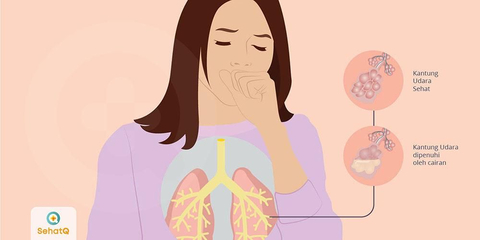Coronavirus disease 2019 (COVID-19) caused by severe acute respiratory syndrome coronavirus 2 (SARS-CoV-2) has been designated as a global pandemic by the World Health Organization (WHO), which is currently being a major challenge focus of major health problem worldwide. Coinfection of SARS-CoV-2 with another microorganism, including fungi, can cause difficulty in diagnosis and a worse prognosis.
Pneumocystis Jirovesii Pneumonia (PJP) is a common opportunistic infection in the human immunodeficiency virus (HIV). However, some people didn’t know they were infected with HIV because some HIV symptoms may not appear within a few years, and a new HIV diagnosis is discovered when the stage of infection has continued along with the diagnosis of PJP.
We reported a 24-year-old man who came and was hospitalized with symptoms of fever, cough, sore throat, and shortness of breath. Reverse transcriptase-polymerase chain reaction (RT-PCR) tested positive for SARS-CoV-2. Early thoracic photos show a picture of a suspected bilateral ground-glass opacity diffuse COVID-19 with a differential diagnosis of Pneumocystis Jirovesii Pneumonia (PJP). Because there is a PJP picture of the thoracic photo results, an HIV test is carried out. This is because PJP is so common in HIV patients as PJP is an opportunistic infection in immunocompromised patients. HIV testing was done because HIV-related patient information in patients is unknown.
HIV test results in patients showed reactive. Therefore, the diagnosis of PJP is confirmed based on the results of thoracic photos and HIV tests. Confirmation of this diagnosis is done without taking a respiratory specimen in the patient for the diagnosis of PJP because the hospital where the patient is a type C hospital where there is no microscopic test or Bronchoalveolar Lavage Fluid (BALF). In addition, confirmation of the diagnosis of PJP is also done because the BAL method and sputum induction to obtain specimens from the respiratory tract is known to be a procedure that produces aerosols or sparks that increase the risk of COVID-19 transmission.
Treatments for COVID-19 are preferred for these patients with the administration of remdesivir, heparin, vitamin D, vitamin C, methylprednisolone, and oxygen simple mask. Treatment for PJP was done by administering cotrimoxazole. An evaluation of the serial thoracic photo showed improvement and rt-PCR results on the 10th day of hospitalization. The patient was subsequently under patient after 25 days of treatment in the hospital and began treatment for HIV.
Cases on these patients showed that radiology findings that show COVID-19 and PJP play a significant role in decision-making on HIV tests. Furthermore, HIV testing in COVID-19 patients can be considered as a part of screening in patients with PJP, especially in patients with unknown HIV status. Determination of corticosteroid administration with the right dose is very important for treating COVID-19 and PJP with severe clinical symptoms. Comprehensive diagnosis and proper treatment are essential for primary and secondary infections in pandemic situations such as the current one to reduce morbidity and mortality.
Author: Dr. Soedarsono, dr., Sp.P(K)
Detailed information from this research can be seen in our article at https://www.sciencedirect.com/science/article/pii/S1930043321006488?via%3Dihub
Amelia Tantri Anggraeni, Soedarsono Soedarsono, Bambang Soeprijanto. Concurrent COVID-19 and Pneumocystis jirovecii pneumonia: The importance of radiological diagnostic and HIV testing. Radiology Case Reports. 2021; 16(12): 3685-3689. https://doi.org/10.1016/j.radcr.2021.09.002





